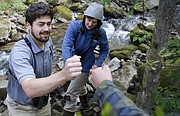A Louisiana waterthrush sang and danced above the Bee Branch tributary along the Middle Creek watershed. The 6-inch bird worked tirelessly to intimidate a mechanical replica sitting on a rock in the middle of the water. The faux intruder aggravated the waterthrush with its mere presence and a song of its own trumpeting from two nearby speakers.
The male bird charged toward the replica, unknowingly flying under a net before retreating to take another pass. The real bird was trying unsuccessfully to shoo away the intruder. It quickly backed away, flying again under the net and settling on a nearby rock before charging a second time. It repeated the sequence once more.
Two researchers and an intern huddled nearby signaled the call from the speakers again, instigating the bird to charge a third time. This time they had it. The bird flew into the net spanning the tributary and was trapped. The workers shuffled over and quickly gathered the bird for some quick testing before releasing it back into its habitat.
"The goal of this is to investigate the population trends by tracking their migration," said Eliot Berz, Tennessee River Gorge Trust avian and research technician.
The trust began studying the birds two years ago. The first years were spent determining whether Louisiana waterthrush could safely carry a geolocator. Once researchers found they could, the trust turned its focus to studying migratory patterns in larger quantities.
The Louisiana waterthrush is an indicator species that can help researchers determine the health of a stream. They feed on macroinvertebrates - small organisms that live underwater - that are sensitive to water quality changes and are found in small streams with rapids and high water quality. The local group - Berz, fellow avian and research technician Holland Youngman and intern Juan Sandoval - are part of a larger study in four states tracking Louisiana waterthrush and worm-eating warblers, which are often found in the same habitat as the waterthrush.
In the four research sites - Tennessee, Arkansas, Ohio and Pennsylvania - populations are changing. In Tennessee and Arkansas, the waterthrush population is increasing while the warbler population is declining. In Ohio and Pennsylvania, it's the opposite.
"There's no noticeable habitat changes, so that leads us to believe the limiting factors are likely somewhere other than their breeding grounds in Tennessee," Berz said.
The group has marked 10 waterthrush with geolocators this migratory season and plans to mark five more. When captured, the group bands and measures the birds and takes blood samples.
"That can tell us a lot of different things," Youngman said. "It can tell if the bird is stressed and gives us an overall health picture."
Youngman and Berz also are banding other waterthrush without geolocators to continue monitoring their health to ensure the devices do not cause harm.
The crew will return next year to collect the birds, retrieve the data and find where the birds are traveling in Central America. That information will allow them to study where they're traveling and determine what could be causing a population shift.
Contact staff writer Mark Pace at mpace@timesfreepress.com or 423-757-6659. Follow him on Twitter @themarkpace and on Facebook at ChattanoogaOutdoorsTFP.

